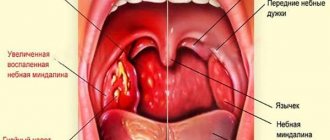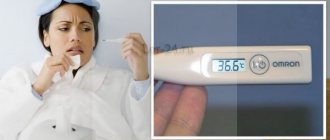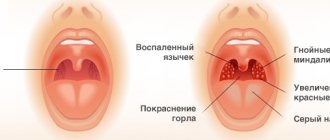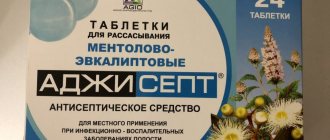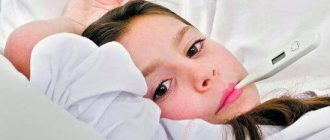Stages of development and symptoms
After the incubation period, obvious symptoms of herpes sore throat begin to appear.
The disease proceeds in waves, then retreating, then returning again. Herpetic tonsillitis is characterized by its own stages, distinguished by a set of symptoms:
- 1st day of the disease – symptoms develop rapidly, the temperature rises sharply to 39-40.5 degrees, weakness appears, and appetite is lost;
- 2-3 days - a rash forms on the surface of the laryngeal mucosa, which looks like small blisters filled with serous fluid (they are bright red, which may change to whitish the next day, see photo). At this stage, the temperature becomes lower than on the first day, but the symptoms of intoxication increase. Aches appear throughout the body, the child complains of thirst, sore throat, and inability to swallow food and water normally. On the 3rd day, the temperature rises again, reaching its peak, the tonsils may enlarge (although not always), the baby feels heavy, becomes capricious, refuses to eat, sleeps poorly;
3-4 days - the condition improves, the temperature drops to 37-37.5 ° C, the bubbles (vesicles) covering the mucous membrane of the throat begin to burst, leaving behind small erosions;
- 5-6 days – signs of intoxication disappear, the child develops an appetite, the sore throat stops, and body aches subside;
- 7-8 days - the erosive surface remaining after opening the vesicles heals, the crusts fall off and are washed off with saliva, the symptoms of inflammation in the throat disappear;
9-10 days - the lymph nodes acquire their previous sizes, but the inflammatory process in them does not go away completely, persisting for up to two weeks.
It is quite simple to distinguish herpes sore throat in a child from its other types - painful bright red papules appear on the surface of the throat within 2-3 days.
Because of the shade, parents think that they are filled with blood, but after a day, the color of the bubbles changes. The serous contents of a transparent or whitish color are clearly visible in them.
The diameter of the rashes can reach 1-2 mm, and their number varies from 6 to 12 pieces. In children with weakened immune systems, the disease occurs in waves; on the third day, 5-6 more bubbles may be added to the blisters that have already appeared, and the temperature rises.
The mucous epithelium of the baby's larynx looks swollen and reddened, with obvious signs of inflammation. The sore throat can be so intense that it is difficult for the child to eat and drink, and lightly touching the sores causes a lot of discomfort.
Each papule is surrounded by a bright red rim, and it is impossible to squeeze out the serous contents from it, and you should not try to do so. After 3-4 days, the blisters will open on their own, and the crusts and erosions will heal.
So, the symptoms of herpangina in children boil down to the following:
- sudden onset of the disease, which starts with an increase in temperature to 39-40°C;
- acute pain in the throat, which intensifies while eating and drinking - they do not radiate to neighboring areas (temples or ears), but the child constantly feels a tingling sensation on the mucous membrane;
- enlarged lymph nodes (under the jaw, near the ears);
- accompanying symptoms – dry cough, runny nose, intoxication;
- undulating course with exacerbations on days 1 and 3 after the acute onset of the disease.
The difference between herpetic sore throat in children and ARVI (with which it is often confused due to the similarity of the initial symptoms) is that the pathology appears more often in the summer-autumn period, when colds recede into the background.
Also, herpangina is not characterized by abundant flow of mucus from the nose.
Due to the active effect of enteroviruses on the mucous tissue of the gastrointestinal tract, herpangina in children is often accompanied by nausea, abdominal pain, bloating and increased gas formation. Severe migraines and seizures are common, especially in children with weak immune systems.
If the course of herpes sore throat in a child is severe, it is better to admit him to the hospital. The pathology is fraught with dangerous consequences - these are serous meningitis, myocarditis and Kernig's symptom.
Attention:
Recovery occurs on days 7-10, when the manifestations are left behind, but at this time the child is still contagious to others. He needs isolation from his peers and family for at least another 5-7 days.
How does the infection manifest?
Herpetic sore throat in adults occurs with less severe intoxication than in children.
The incubation period lasts from one to two weeks. 3–7 days after infection, the pathogen enters the bloodstream and spreads throughout the body. As a rule, the disease does not manifest itself clinically until this period.
This is what a pinpoint rash in the throat looks like 2–3 days after the temperature rises
At the end of the first week, symptoms of herpetic sore throat appear, they are similar to complaints with ARVI:
- the temperature rises, it is characterized by fairly high numbers (39 – 41°C);
- sore throat when swallowing;
- body aches;
- headache;
- weakness;
- runny nose;
- cough;
- enlargement and soreness of the submandibular, cervical, and postauricular lymph nodes;
- nausea, possible vomiting and diarrhea.
Since enterovirus almost always manifests itself as a gastrointestinal disorder, it is important not to mistake this disease for an infection associated with bacterial infections or food poisoning.
Causes
Herpesvirus infections in the body of an adult are not dangerous for general health if the number is small and the immune system is strong. Many people are asymptomatic carriers of the infection without even knowing it.
As soon as the protective functions are reduced, the herpesvirus infection activates its effect on systems and organs, provoking a number of pathological manifestations. The severity of relapses, their frequency and duration depend on the affected area. On the lips, exacerbation in normal health is allowed up to 3 times during the year.
Symptoms of herpes sore throat depend on the causative agents of the pathology. Over many years of medical practice, experts have identified a number of factors that most often develop herpetic tonsillitis:
- constant violation of the daily routine, poor rest at night;
- physical and psychological overload for a long time;
- hard physical labor;
- general hypothermia of the body;
- chronic diseases of various types (pathology of the liver, lungs, tuberculosis, impaired functioning of the cardiovascular system, viral hepatitis, allergic manifestations in areas of the upper tract of the respiratory system);
- work in cold and damp rooms;
- complications after acute respiratory viral infections, acute respiratory infections;
- overweight;
- diabetes;
- diagnosing hypothyroidism;
- starvation;
- illiterate vegetarianism;
- cachexia.
Herpes sore throat, treatment is provided at the first symptoms. Sometimes patients delay going to the doctor, which provokes the severity of the pathology. You can often hear from a doctor questions that are relevant to patients, such as how the disease is transmitted, whether it is contagious, how one can become infected, and how to treat it. A qualified specialist must give extensive answers to all questions, providing informational material to the infected person. The calmer the patient’s condition is, the more effective the therapy will be and the desired recovery will occur in a short time.
Herpes sore throat can worsen against the background of autoimmune pathologies. Long-term use of glucocorticoid and cytostatic drugs sometimes becomes a favorable factor for the formation of the disease.
Hard physical labor.
Contagiousness of herpetic sore throat
The disease is predominantly caused by Coxsackie viruses, which belong to the enterovirus family. This is one of the most common groups of pathogens that are found everywhere. This means that you can catch the infection in different ways.
Herpangina is considered a contagious disease and can easily be transmitted from one child to another. There are different routes of infection - airborne, fecal-oral, contact. Viruses can enter a child’s body through dirty water, unwashed food, through dirty hands, or through contact with household items on which sputum with the virus is left.
Most often, the virus spreads through the air from a sick child to a healthy child. Less often - by contact. Although the pathogen is transmitted from person to person, occasionally animals can also be its sources.
Children under three years of age are especially at risk of contracting herpes sore throat during an epidemic. But the disease does not spare schoolchildren, teenagers, as well as adults who have already had a sore throat.
How to prevent and forecasts
Herpetic sore throat in a child and its causes can be prevented by following simple rules of prevention:
- Maintain a high level of immunity with proper nutrition and regular exercise or walks in the fresh air.
- Observe drinking regime, ventilate and humidify the air in the room where people stay for a long time.
- Do not contact people who have herpangina or were sick no longer than 2 weeks ago.
Enteroviral pharyngitis is not chronic or recurrent. Having been ill once, the body becomes resistant to the pathogen. Almost all children suffer from this disease; it spreads quickly in children's groups and causes an outbreak of epidemics, but in adulthood, contact with the pathogen is no longer dangerous.
How and with what to treat herpes sore throat
The method of treating the disease in adults is selected by the doctor. There are no specific therapeutic regimens. Symptomatic and etiotropic methods are used. In case of complications of the disease with a bacterial infection, antiseptics are prescribed.
Diagnostics
To identify herpetic sore throat, serological and virological tests are used. To carry out the first, sera obtained in the first days of the disease and 2 weeks after its completion are used. The most informative is the immunofluorescence reaction. In differential diagnosis, the patient’s age, type and location of the rash are analyzed.
To identify herpetic sore throat, serological and virological tests are used.
Blistering rashes are found on the mucous membranes of the throat, no bleeding is observed. There are no symptoms of gum inflammation. A general blood test reflects a moderate increase in the number of leukocytes, which indicates the presence of an inflammatory process.
Drug therapy
To reduce the temperature, antipyretic drugs are used - Paracetamol, Ibuprofen. If a sore throat is accompanied by signs of intoxication of the body, it is advisable to take anti-inflammatory drugs. Nimesulide is considered the most effective.
Additionally, local treatment is prescribed to eliminate pain, swelling and irritation of the mucous membranes. The larynx is treated with Vinilin solution, after which an antiseptic spray is used. The aerosol is sprayed 3-4 times a day. A solution of sodium tetraborate or lidocaine eliminates the symptoms of inflammation and quickly relieves pain.
If a sore throat is caused by any type of herpes virus, it is treated with Acyclovir. The tablets are taken according to the regimen prescribed by the doctor. When bacterial infections occur, antibiotics are prescribed
They must be used with extreme caution, due to the possibility of aggravating the severity of the viral infection. Any antibacterial agent is recommended to be taken in combination with probiotics
Antihistamines prevent the development of allergic reactions.
Rinse and irrigate is not suitable for preschool children. In this case, use safe antiseptics, for example Lugol's solution or Miramistin. Using a stick wound on cotton wool, the tonsils and palate are treated.
Folk remedies
Traditional recipes complement traditional treatment well. If a person is not allergic to propolis, this product can be chewed several times a day. To treat sore throat, rinse and irrigate with apple juice. This liquid is used to gargle 4-5 times a day. Before the procedure, it is necessary to keep the product in the refrigerator.
Treatment of herpes sore throat is carried out using honey and garlic. The vegetable is pressed, mixed with honey and simmered over low heat for half an hour. After this, the drug is diluted with boiled water and taken 1 tsp. Every hour, rinse your mouth with a decoction of sage, chamomile or calendula. To treat tonsils in children of the first year of life, a syringe without a needle is used. The patient should drink as much liquid as possible - mineral water, tea, rosehip infusion, berry juice.
Treatment of herpes sore throat is carried out using honey and garlic.
Prevention
No specific preventive measures have been developed. It is necessary to observe the rules of personal hygiene, avoid close contact with infected people, and refuse to visit public places during epidemics. Infected people should stay at home in a well-ventilated room. If an employee of a medical or children's institution falls ill, he is suspended from work for 2-3 weeks.
Individual prevention is aimed at strengthening the immune system. This will reduce the likelihood of infection, and if it does occur, the disease will be mild. In a normal state of defense, angina does not have pronounced symptoms. A good prevention of viral infections in children in the first year of life is breastfeeding.
A good prevention of viral infections in children in the first year of life is breastfeeding.
What and how to treat?
Bed rest should be observed during illness.
After diagnostic procedures, the patient is prescribed individual, comprehensive treatment for herpes sore throat. The prescribed drugs eliminate pain and suppress the activity of the virus. An important part of treatment is a special diet, in which all food should be taken in liquid form, so as not to further injure the mucous membrane. The patient must remain in bed and be isolated from others so as not to infect anyone.
Complications.
Complications are observed in exceptional cases. Occurs in children with weakened immune systems. Complications caused:
- rash on the body;
- problems from the SSS;
- penetration of a bacterial pathogen;
- herpetic meningoencephalitis in children;
- serous meningitis;
- the appearance of Kerning's symptom, one of the important and early signs of irritation of the meninges during meningitis, hemorrhages under the membranes and some other conditions;
- pyelonephritis.
After an infection, children develop stable immunity to a specific strain. However, when another type enters the body, the disease recurs.
Clinical picture
Penetrating into the body, the causative agent of the disease immediately affects the lymph nodes, then the circulatory system, and from there, through the bloodstream, it enters the oral cavity. Here it begins to actively develop and reproduce.
You should know! Herpes sore throat gets its name because, when observed through a digital microscope, its symptoms resemble ordinary herpes.
Signs of the disease are varied and depend on the child’s immunity. The weaker the defenses, the more pronounced the herpangina will appear. There are several general symptoms of the disease that are characteristic of almost every case:
sudden temperature changes up to 39-40°C;- loss of appetite;
- joint pain;
- general weakness;
- enlarged nodes of the lymphatic system;
- problems in the gastrointestinal tract, manifested by nausea and diarrhea;
- feverish condition.
A characteristic sign of a viral disease is multiple red rashes in the mouth. In appearance, the rash looks like watery formations that begin to open 3-4 hours after appearance.
After opening the blisters, erosions and ulcers form on the surface of the mucous membrane, healing for a long time (up to 7-8 days). In this case, the affected area swells. The child feels pain and discomfort when swallowing saliva and eating food. The symptoms of the disease gradually intensify; the pain is accompanied by itching and enlargement of the cervical lymph nodes.
Full recovery from an illness occurs only on the tenth day, unless a secondary infection is added to the main disease. But even after recovery, the child remains infectious to others for some time. In children with weakened immune systems, a relapse of sore throat is often observed, accompanied by a feverish state and severe intoxication.
Sometimes herpes in a child’s throat manifests itself in an atypical form without the appearance of watery blisters and plaque on the mucous tissues. In this case, the rashes affect the baby’s arms and legs, posing a danger to his health. After all, after opening the papules, there is a high risk of reinfection. In this case, you cannot treat the disease without consulting a doctor.
Sometimes with herpes sore throat, vesicular stomatitis develops - a rash appears on the tongue, the inside of the neck and gums. Despite the high temperature, stomatitis proceeds without complications and ends after 6 days, leaving no scars or scars on the tissues.
Causes
The main cause of sore throat is the Coxsackie virus type A and B. Some factors provoke the development of the disease:
- warm season - the pathogen is usually activated in the summer or early autumn;
the presence of herpes virus in the human body;- decreased immunity;
- problems with bowel function;
- overheating or hypothermia;
- overeating cold foods;
- frequent stressful situations;
- allergic reactions.
Another cause of the disease is a child visiting crowded indoor spaces, for example, a school or kindergarten. The older the child who becomes infected with the disease, the more severe his sore throat will be.
Treatment differences between adults and children
The main difference is in dosages: for children it is less than for adults. In this case, the treatment regimen must be selected individually, always with a doctor. In the case of sick children, any self-medication can have a disastrous effect, causing serious complications.
Adult patients are advised to drink plenty of fluids. It helps bring down the temperature. In the case of children, this method is unlikely to work, since in young patients the pain is more acute. Often they cannot swallow at all, especially during the period of rapid development of the disease with full symptoms.
Children are advised to take vitamins appropriate for their age. Even better is a multivitamin designed specifically to strengthen the immune system. They will not have a strong effect, but will help speed up recovery and at the same time prevent complications and relapses.
Drug treatment
There are currently no specific antiviral drugs developed against enteroviruses. Therefore, treatment of the disease is symptomatic.
When body temperature rises above 38 0C, antipyretics are used: Nurofen, Paracetomol, Efferalgan, Ibuprofen. Medicines based on Ibuprofen also have an analgesic effect (relieve headaches, abdominal pain, etc.).
Important to know: How to treat sore throat at home
To reduce swelling of the tonsils and eliminate itching, antihistamines are prescribed: Suprastin is used for children from the 1st month of life, Erius and Zyrtec can be given to babies from 6 months of age.
When diarrhea occurs, the physiological balance of the child’s intestinal flora should be maintained. For these purposes, you can use “Baktisubtil”, “Bifiform”, “Gastrolit”. These drugs are used to treat children from infancy.
Possible complications of the disease
Herpes sore throat is provoked by enteroviruses that cause intestinal infections. These pathogenic microorganisms are widespread, so there is always a chance of infection. The pathogen is transmitted by airborne droplets, contact and fecal-oral routes.
You can become infected not only from a person whose disease is in an acute form, but also from someone who is completing the recovery process. In some children, even after all signs of the disease have disappeared, the body continues to release virus virions into the surrounding space. This process may continue for another three or four weeks.
The risk of illness increases if the child is weakened and his immune system is not functioning well. This may occur due to the natural imperfection of the child’s immunity. The body's defenses may also be weakened due to the fact that the child has recently had an infection.
In most cases, in children with good immunity, the disease can be cured completely, without dangerous consequences. A complicated course of the disease is more often observed in young patients under the age of one year, since their immune system is still in the process of formation.
The main danger of Kosaka viruses is that they are able to integrate into nerve fiber cells. Once in the blood, along with its current, the virus can enter the tissues of various organs: the brain and spinal cord, heart, liver, and digestive organs. Penetrating into the tissue cells of the central nervous system, the virus is able to provoke inflammatory processes in various parts and membranes of the brain.
The danger of enterovirus is also that after the symptoms of herpes sore throat have completely passed, individual virions can remain viable. In such cases, delayed consequences may develop. Heart complications may occur - the development of cardiomyalgia, myocarditis. If the virus penetrates the cells of the liver and kidneys, inflammatory processes in these organs may develop.
Herpangina symptoms
High fever, sore throat and rash on the lymph nodes are symptoms of the virus.
Despite the fact that the pathology is usually called sore throat, however, it refers to viral diseases. Characteristic of tonsillitis is damage to the tonsils by bacteria, in most cases streptococci. Herpangina is a viral disease that is correctly called “enteroviral vesicular pharyngitis.” The clinical picture of the pathology also differs from tonsillitis. Symptoms of herpes sore throat in children:
- difficulty swallowing and loss of appetite;
- high temperature up to 40 degrees;
- nasal congestion, unilateral conjunctivitis;
- the appearance of painful, cutting sensations in the throat, swelling;
- watery rashes on the lymph nodes, possible manifestations on the arms and legs.
With a complicated course of the pathology, the following symptoms are possible:
- pain in the heart, kidneys or other organs that are exposed to the toxic effects of pathogenic microorganisms.
- With meningitis, muscle spasms are possible.
- diarrhea and symptoms of dehydration.
Herpes sore throat - treatment
Once diagnosed with herpetic sore throat, treatment is aimed at reducing symptoms. Antibiotics for herpetic sore throat are ineffective, so they are not prescribed, with the exception of a bacterial infection (Penicillin, Augmentin, Amoxiclav, Ceftriaxone are prescribed). In some cases, the doctor may recommend antiviral drugs or immunomodulators (Immunal, Rioflora, Immuno, Imudon). You can take this type of medication only as prescribed by your doctor. Rules for successful treatment of herpetic sore throat:
- Isolating the patient
, providing him with individual hygiene products and utensils is necessary to prevent infection of other family members. - Ensuring bed rest
- due to severe weakness, the patient should be at rest, the body's strength should focus on eliminating the infection. - Correction of the patient's diet
- all foods that irritate the throat, hard fruits and confectionery, cold and hot dishes, spices should be excluded; the main diet should consist of thin porridges, cottage cheese, soups. - Ensuring a drinking regime
- a patient with herpetic sore throat should drink a lot of liquid at room temperature, best of all - fruit drink, tea with lemon (non-acidic), juice with a neutral taste.
Herpetic sore throat - medications
When diagnosed with herpetic sore throat, antiviral drugs should be prescribed by a doctor, taking into account the strain of the virus that caused the specific disease, as well as the patient’s condition. Most commonly prescribed drugs:
- Viferon;
- Cytovir;
- Cycloferon.
Acyclovir is completely ineffective for herpes sore throat - it only acts against the herpes virus, so you should not take it - at best it will be useless.
For severe sore throat, you can use painkillers and lozenges - Strepsils, Tantum Verde lozenges, Septolete, Grammidin. You should not get carried away with them, so as not to cause the vesicles to burst too early. For antiseptics and anesthesia of the throat, you can use sprays Yox, Hexoral, Ingalipt, Kameton, however, these drugs have age restrictions - they cannot be used by children under 3 years of age. An alternative is to lubricate the throat with Lugol's solution, but this drug is prohibited for thyroid diseases and allergies to iodine.
At high temperatures, the doctor prescribes antipyretic drugs - Nurofen, Ibuprofen, Panadol, Paracetamol. It is worth bringing down the temperature only if it is above 38 degrees in a child and 39 degrees in an adult. In some cases, for herpes sore throat, antihistamines are prescribed - Loratadine, Diazolin, Claritin, Zyrtec. They are necessary if an allergy appears against the background of the disease.
How to gargle for herpes sore throat?
For herpetic sore throat, inhalation and heating are prohibited - they can accelerate the spread of infection. Various rinses are used as local treatment - with medications, herbal decoctions and other means. Gargling reduces pain and disinfects the throat well; procedures are carried out up to 5-6 times a day. Effective gargling for herpes sore throat:
- pharmaceutical drugs – Furacilin, Rotokan, Miramistin, Angilex;
- a solution of salt or soda - 1 teaspoon of the substance is dissolved in a glass of warm water, you can add 2-3 drops of iodine;
- decoctions or infusions of chamomile, calendula, sage, coltsfoot, oak bark.
Quartz for herpes sore throat
Those who are looking for an answer to the question of how to treat herpes sore throat in children, pregnant women and other groups of patients who do not tolerate medications well may have the idea of treating a sore throat with quartz. Doctors do not recommend this method - for this disease it is completely ineffective and can even be dangerous if the patient gets burns during the procedure. Based on recent research, quartz lamps are effective only for disinfecting air and surfaces.
Herpes sore throat - folk remedies
Traditional medicine can also tell you how to treat herpetic sore throat. These funds can be used as an addition to drug treatment, preferably after approval of the method by the attending physician.
The most effective folk remedies for the diagnosis of herpetic sore throat:
- Freshly squeezed aloe juice - take 1 tsp. morning and evening, the product strengthens the body's defenses and accelerates the healing of wounds in the throat.
- Alcohol tincture of propolis – 1 tsp. Dilute the product in a glass of water and gargle with the solution.
- Chew pure propolis (about 2 g) in the mouth like gum for 10-15 minutes 2-3 times a day.
- Kalanchoe - the leaf of this plant should be chewed until the juice stops secreting, the cake should be spat out, the procedure should be repeated 3 times a day.
- Honeycombs – chew honeycombs with honey several times throughout the day.
Principles of the therapeutic approach
Treatment of herpes sore throat in adults in an uncomplicated form is not particularly difficult and is similar to the treatment of any enterovirus infection.
Due to the fact that the disease is very contagious, isolation of the patient is required. The patient is provided with separate dishes and personal hygiene items. If the course of the infectious process is severe, bed rest is prescribed.
The most important thing in therapy is to drink plenty of fluids. The fluid removes toxins from the body and replenishes moisture lost during excessive sweating or diarrhea. You can drink juices, fruit drinks, compotes, water. It is important that the drink is at room temperature (hot and very cold solutions irritate the pharyngeal mucosa).
Drinking plenty of fluids is necessary to restore the amount of fluid in the body and to remove toxins
Food should be liquid or semi-liquid, easily digestible and fortified. There is no need to eat high-calorie foods. Meat and fish are used only in the form of minced meat, steamed. Vegetables and fruits are not given raw. The patient is fed frequently (5–7 times a day), in small portions. Dietary table according to Pevzner No. 13.
There are no special drugs against the Coxsackie virus. If the pathogen has already penetrated the body’s cells and began to multiply there, and the patient does not have a severe course of the disease or complications, then you just need to wait until antibodies against a specific type of infection are formed and the remnants of viral particles are destroyed. In adults this can happen by 7–8 days, in children – by 8–10.
Based on this, treatment of herpetic sore throat in adults is mainly symptomatic:
- Antipyretics, non-steroidal anti-inflammatory drugs (Nurofen, Paracetamol, Efferalgan).
- Gargling with chamomile, sage, calendula, baking soda solution. These drugs have disinfectant properties and prevent the addition of secondary microbial flora. They also relieve inflammation and reduce pain. You should not use hypertonic saline solutions, they irritate the already inflamed mucous membrane.
- Painkillers (Hexoral Tabs, Tantum - Verde, Theraflu Lar, Trachisan, Septolete, Lidocaine solution, Dicaine).
- If there is a pronounced allergic component, antihistamines (Suprastin, Tavegil, Claritin) may be prescribed.
You can read about how to treat herpes sore throat in children here.
There are different opinions about the use of antiseptics for irrigating the throat, lubricating the throat with a solution of brilliant green or Lugol. In practice, it has been proven that these measures are ineffective and traumatic for the mucous membrane, therefore it is not advisable to treat a patient with herpetic sore throat with these remedies.
The infection has nothing to do with the herpes virus, so Acyclovir and other drugs belonging to this group are completely useless.
Inhalations and warming compresses are simply unacceptable for this pathology. All methods involving the use of heat are based on improving blood circulation and dilating the blood vessels of a given area. When these procedures are used in a particular case, the viral infection begins to spread more actively throughout the body, which aggravates the process and course of the disease.
Ultraviolet irradiation for this pathology is ineffective, and the likelihood of burns is quite high.
To summarize, it can be noted that drinking plenty of fluids, antipyretics and local painkillers are the main treatment for uncomplicated forms of the disease.
Is it possible to get infected with herpetic sore throat?
Yes, it is possible and very easy. The susceptibility of children to these viruses is quite high. The virus enters the external environment with the patient’s secretions (saliva, mucus from the nasopharynx, feces). When a sick child enters a children's group, the disease quickly spreads among the children. The virus can get from a sick child to a healthy one in several ways.
3 ways to get infected with herpes sore throat
- Airborne. When talking, coughing or sneezing, the virus from the patient with particles of saliva enters the air and circulates in it. When there is a large concentration of children in one room (in kindergartens, schools or at family holidays), the virus quickly spreads through the air and enters the body of healthy children through breathing. This is the most common method of infection.
- Fecal-oral. Infection occurs less frequently this way. The virus enters the body along with toys, pacifiers or other objects with which the sick child has previously been in contact. You can also become infected through food, dishes and dirty hands. In other words, a healthy child ingests the virus remaining on things or objects that were previously used by someone with herpangina.
- Contact. Infection occurs through direct contact of a healthy child with a sick child through mucus flowing from the nasopharynx. Young children can hug, kiss, bite or lick each other and easily contract an infection.
You can become infected from a sick person, from a carrier of the virus, who may not show any signs of illness, or from a recovering person, who can release the virus into the environment for another 3-4 weeks. Rarely, pets, with whom children love to play, can become a source of infection.
Herpangina can be caught at any time of the year, but a sharp increase in incidence is observed in the summer-autumn period. It is from mid-summer and throughout the fall that the number of cases increases, and the risk of infection also increases.
More often than others, children under 10 years of age get sick. Although herpangina occurs among all ages, cases of the disease are recorded much more often among children under 10 years of age. It is worst for children under three years of age; their disease is always more severe than others. In babies under six months of age, herpangina is extremely rare due to passive immunity (antibodies obtained from mother's milk), which protects them from infection.
Methods for diagnosing herpes sore throat in children
Herpetic sore throat in children and adults is recognized by a doctor based on similar signs. There are very few cases of the disease in infants under 6 months of age, because they are protected by maternal immunity transmitted at birth and breastfeeding. Herpetic sore throat is diagnosed upon examination by an experienced specialist based on the presence of specific symptoms. To diagnose adult patients, you need to contact an ENT specialist or an infectious disease specialist. To clarify the diagnosis, the following studies are carried out:
- general blood analysis;
- diagnostic sera labeled with fluorescein;
- serological reactions;
- analysis of washout from the affected area.
Herpes viral sore throat is characterized by a surge in infection in the summer; the epidemic worsens at the end of summer, because viruses actively spread in hot climates.
Causes of sore throat
The background factor in the development of Zagorsky syndrome is a weakening of the immune defense. It is, of course, easier for a child’s body to be undermined by negative influences. In principle, a certain weakness and vulnerability of the immune system of children is almost the norm, associated with the inevitable costs of growth and development of the body.
The main reasons for the decrease in immune reactivity are:
- The presence of foci of chronic infection in the body (with tuberculosis, hepatitis, helminthic infestations), or a recent acute infection (influenza, for example).
- The presence of a chronic inflammatory process in the body, which may be caused by autoimmune reactions or allergies.
- Long-term drug therapy with drugs that have an immunosuppressive effect (5-Aminosalicylic acid, glucocorticosteroids, Azathioprine, etc.).
- Long-term stay in regions with an unfavorable external environment (ecological collapse and/or continental climate).
- Lifestyle conditions (poor diet, constant stress, alcohol abuse, smoking).
When the immune system reaches a certain level of vulnerability, invasion and further development of pathogens of herpetic sore throat becomes possible.
These are RNA viruses:
- Coxsackie viruses - 29 serotypes, distributed into groups A, B, C;
- ECHO viruses (echoviruses) are considered opportunistic, which is confirmed by the disease scenario: when the immune system is weakened, the opportunistic microflora becomes dangerous.
Coxsackie viruses
Association by serotype means that these viruses have a similar antigenic structure, detected by serological tests. In 85% of those cases when the sore throat in question is caused by Coxsackie viruses, these are viruses of group A. Their target is the dermis and mucous membranes (hemorrhagic conjunctivitis, herpes sore throat, in very rare cases the membranes of the brain are affected - aseptic meningitis).
Much less frequently, Zagorsky syndrome is provoked by group B. But in this case, the infection does not linger in the throat, but moves further. The serous membrane of the heart and directly the heart muscle, pleura, liver, and pancreatic tissue are attacked. And such pathologies as myocarditis, pericarditis, and nonspecific hepatitis arise (i.e., hepatitis caused by a non-hepatotropic pathogen). Group B is more likely to cause negative complications. There are no cases of group C herpetic tonsillitis described.
With a normally functioning immune system, Coxsackie viruses often do not provoke an open course of the disease at all, being asymptomatic. Like hepatitis B, for example. And in the same way, a stable immunity specific to these viruses is formed, eliminating the risk of relapse. Therefore, enteroviral vesicular pharyngitis is often compared to chickenpox. As a rule, patients become ill in childhood, and once they are ill, they become virtually invulnerable to this infection in the future.
Echoviruses
The name is associated with an English abbreviation, which in the years of the discovery of the virus (50s) meant that this group of viruses was not related to known diseases. Echoviruses cause opportunistic pathologies because opportunistic, and can be detected in small concentrations in a completely healthy person. A unique property of this group of viruses is their extreme infectiousness (the virus can penetrate almost any tissue). Penetrating into the body, viral virions can begin to replicate first in the nasopharynx and then in the lymph nodes. However, the main route of infection here is nutritional. Therefore, echoviruses begin to multiply most actively in the gastrointestinal tract, especially in the large intestine.
But symptoms begin when viral virions reach the main internal organs - liver, heart, spleen, bone marrow, lungs and even kidneys. In the tissues of these organs, virus replication can last for a week. The severity of symptoms also depends on the intensity of pathogen reproduction. It is curious that, in addition to childhood, echoviruses “prefer” males; females are much less susceptible to this pathogen.
As with Coxsackie viruses, the basic scenario here also leads to the emergence of persistent, almost indefinite immunity. In most cases, the cause of herpes sore throat is the Coxsackie virus. Specifically, the Coxsackie A16 virus.
Treatment of pathology
The baby is treated in a hospital to avoid complications.
Symptoms of herpes sore throat in patients appear when the viral infection has already spread throughout the body and attacks various organs and systems, which is why it is so important to start treating herpes sore throat in time to avoid complications. There are no medications that would directly act on the virus yet, therefore, treatment comes down to eliminating the symptoms.
Treatment of herpes sore throat in children most often takes place at home. To do this, the correct ventilation and humidification regime is observed in the isolated room; this will help improve heat regulation and mitigate the course of the disease. A sore throat in a baby under one year old is treated in a hospital, as the baby often develops complications.
Treatment of herpetic sore throat in children does not differ from therapy in adult patients. Systemic therapy for enteroviral pharyngitis:
- Antipyretic drugs. The drug to which the patient’s body responds best is selected.
- Painkillers. Needed to reduce muscle pain. Take systemic painkillers, and for the throat, gargling with medicinal herbs (chamomile, oak bark, calendula) is possible. Cooling of inflamed areas with ice, cold drinks or even ice cream is also practiced.
- Antiallergic drugs. It is prescribed extremely rarely if there is severe swelling of the throat or other allergic reactions to toxins produced by the virus.
- Antiviral drugs. Prescribed at the discretion of the doctor in case of complicated disease.
- Sorbents. To remove toxic substances from the intestines that are produced by pathogenic microorganisms. Needed if there is diarrhea or with weak kidneys or liver.
